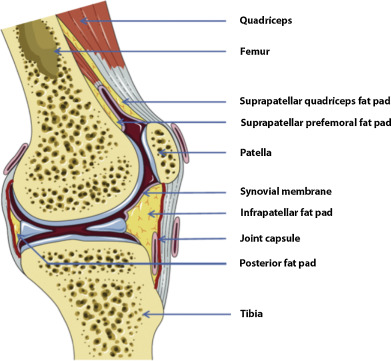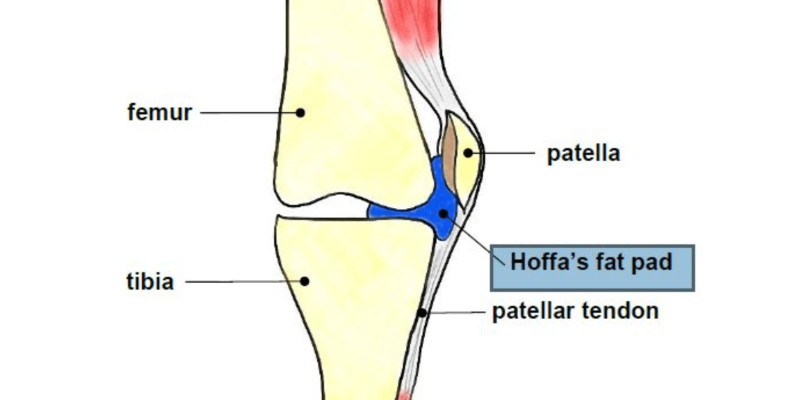The knee fat pad or Hoffa’s pad is the (infrapatellar fatty pad) which sits below your patella (knee cap) directly behind your patellar tendon. It cushions the patella, preventing it from hitting against the condyle of your femur (or end of the thigh bone) in the case of a direct blow to the front of the knee. The fat pad in the knee has a lot of nerve cells, so any injury to it is extremely painful.

Picture source: IPFP
What Causes Fat Pad Syndrome?
Hoffa’s Syndrome is a condition in which the infrapatellar fat pad either suffers a contusion (A forceful blow to the front of the knee i.e. fall, motor vehicle accident, football tackle). In addition, repetitive overload injury resulting in irritation and swelling of the fat pad in some cases (Read more).
This mostly common in those who participate in activities that entail repetitive maximal extension of the knee. This can lead to the Hoffa’s pad becoming trapped between the femur and the patella whenever the leg is fully extended.
More specifically, with extension or hyperextension of the knee, the fat pad is pinched between the distal femur and the tibial spine leading to injury, hypertrophy, and inflammation.
What are the Symptoms ?
- – Pain in the front of the knee
- – Swelling below and around the knee
- – Pain with fully straightening the knee
- – Pain with prolonged walking, squatting and kicking activities
- – Pain with wearing high heels
Treatment and management of Fat Pad
The 1st step before following the management plan is to get the correct diagnosis. These symptoms can also be characteristic of several other knee conditions including patellar tendonitis and patellofemoral joint pain syndrome, so it is best to contact your physiotherapist for a thorough assessment and proper diagnosis.
We have highlighted a couple of steps that you can follow after confirming your fat pat diagnosis.
Management
- 1- Follow the POLICE protocol and avoid HARM in acute cases.
- 2- Avoid any activities that extend/hyperextend your knees (to calm down the symptoms).
- 3- Apply Tape to assist you with a fat pat sensitivity (ask your physio for help).
- 4- Quadriceps and Gluteal muscles Strengthening will be part of your initial rehabilitation plan (should be prescribed by your physiotherapist).
- 5- Improve muscle imbalance in the ipsilateral and contralateral side (Strength, Balance, Coordination, Power), (should be prescribed by your physiotherapist).
- 6- Understanding Loads management and minimise activitis that overlaod the knee (kicking the ball, jumping, etc).
How to Prevent Fat Pad Syndrome?
The best way to prevent occurrence or recurrence of fat pad impingement is to optimize the strength and flexibility of the muscles around the knee, hip, and ankle. Your physiotherapist is an expert at guiding you towards the best exercises to correct any deficits in these areas.
If you have previously battled fat pad impingement it is best to avoid potentially aggravating activities such as kneeling, squatting and kicking for prolonged periods. For females, it is best to avoid or limit walking in high heels.
Before trying these exercises make sure to consult your physical therapist. If you have any question feel free to contact us through [email protected]
Our Approach
Dublin Sports Injury Clinic is a Physiotherapy clinic based in Fitzwilliam Square, Dublin2. we have a holistic approach to our assessment and treatment. The initial assessment helps us to explore the cause of your injury and help you to get pain free shortly and stop any further injuries. We will design a customized training program for you to start with, and we coach you and monitor your progress closely. We will prescribe relative rest or modified activities as required. In addition, the patient’s education helps to reduce frustration and encourages compliance. In our clinic, the treatment of LCL tear will be tailored to every individual.
FOLLOW US ON YOUTUBE AND GET ACCESS TO OUR WEEKLY FREE REHABILITATION EXERCISES.
Next step
Want to get in touch with our team of our therapist or you are looking for some advice? Simply fill in your details below & we get in touch with you shortly.
Disclaimer: This article is for information only and should not be used for the diagnosis or treatment of medical conditions. You can contact us if you would like to book an appointment or get some advice from our therapist.

